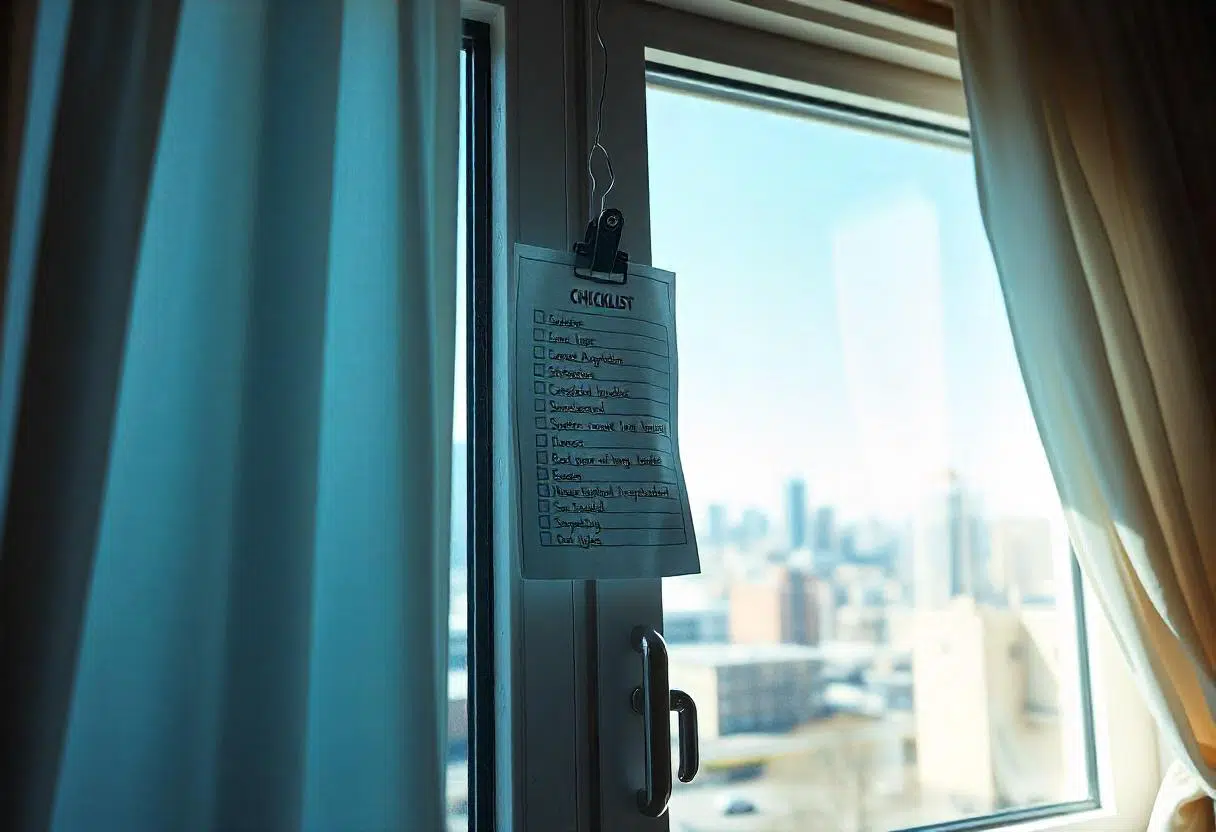Need a window installation checklist? This guide provides all the steps to prepare your home for a smooth and efficient installation, from clearing spaces to managing children and pets.
Preparing Your Home for Window Installation Day
Preparing your home for window installation day helps ensure a smooth and efficient process. Organizing your indoor and outdoor spaces can significantly streamline the work of the installation team, making the entire project run more smoothly. A well-prepared environment allows the crew to focus on their job without unnecessary distractions or delays.
Before the installation crew arrives, the team will conduct a thorough walkthrough to explain the process and address any concerns. This initial meeting provides a valuable opportunity to discuss specific needs and ensure everyone is aligned.
Here are the details on how to prepare your home by removing window treatments, clearing the window area, and disconnecting window alarms.
Remove window treatments and coverings
Start by listing some forbidden forms of the keyword “same window coverings” according to the rule 5. Then, find out if there’s a chance to incorporate the keyword without making any extra assumptions, according to the rule 2. Keep it short.
Begin by taking down all window treatments and coverings, such as blinds, curtains, and shades. This step not only prevents delays during the installation but also avoids potential damage to your window coverings and same window coverings and other wall decorations. If you plan to reuse them, it’s also a great time for a thorough cleaning.
Also, move any nearby wall hangings and decorations, as walls may shake slightly during window removal. Relocate breakables to a safe location to avoid accidents. These precautions help ensure that both your home and belongings remain intact during the installation.
Clear the window area and surrounding space
Next, clear the window area and surrounding space. Move furniture and other obstructions out of a roughly 5-foot radius around each window to facilitate the installation crew’s work. This allows them to access the windows easily and perform their tasks efficiently.
Remove family pictures and other wall decorations that might be near the window areas. The installation team will usually lay down tarps and cover any remaining furniture to protect it from dust and debris.
Disconnect window alarms
For windows equipped with alarms, consult your security provider to safely disconnect them before installation. This precaution prevents any accidental triggering of the security system and ensures a smooth installation process.
By planning ahead, you can avoid unnecessary disruptions and ensure that the window installation process goes smoothly.
Making Space for the Installation Team
Creating ample working space for the installation team is crucial. Ensuring clear pathways and work areas allows the crew to move equipment and materials efficiently, facilitating their work and enhancing overall safety.
On installation day, the crew will greet you and discuss any specific instructions or preferences regarding storage locations for trucks, tools, and waste. They may also inquire about the locations of outdoor power receptacles to ensure they have the necessary resources to complete the job.
Properly preparing both the interior and exterior of your home ensures that the installers can carry out their work smoothly and without interruptions.
Clear pathways and work areas
Ensure all hallways and paths leading to the installation sites are free from clutter for a seamless process. This allows the crew to move their equipment easily and safely. Relocate any furniture and obstacles near the window installation areas to give installers ample space to work, and clear paths to prevent accidental damage to your belongings.
If the crew needs to use ladders, ensure unobstructed access to areas where the ladders will be set up. This is crucial for reaching higher windows and completing the installation safely. Keeping these areas clear contributes to a more efficient and hassle-free process.
Prepare the exterior of your home
The exterior of your home also needs attention before the crew arrives. Trim back overgrown plants and remove items that might obstruct access to the windows from outside. Ensure outdoor areas are free of items like lawn furniture that could impede the process.
Preparing the exterior of your home makes it easier for the installation team to work efficiently and safely.
Plan for children and pets
On installation day, designate safe spots for children and pets away from the work area. This helps ensure their safety and minimizes disruptions.
If possible, consider keeping them out of the house for the day to avoid accidents and reduce stress for both animals and installers. Planning ahead creates a safer environment for everyone involved.
What to Expect During Window Installation
Understanding what to expect during the window installation process can help you feel more at ease and prepared. Communicate with your contractor a few days before the installation to confirm expectations and address any last-minute details. This preparation ensures both you and the installation team are aligned, making the process smoother.
A well-prepared home with clear pathways and organized spaces allows the installation crew to work efficiently and safely. Following a comprehensive checklist can help you avoid surprises and ensure the project meets your expectations from start to finish.
Arrival and setup
When the installation team arrives, they will start by setting up their equipment and preparing the work areas. Ensure your home is ready by following the earlier preparation tips. Clear at least 5 feet around each window by moving furniture, wall hangings, and decorations to provide ample working space. Also, make sure hallways and rooms leading to the windows are free of obstacles. Cover any remaining furniture with drop cloths to protect them from dust and debris.
Prepare the exterior by trimming tree branches, removing lawn furniture, and clearing debris from around the outside of windows. Communicate with the installation team to discuss any specific instructions regarding the process.
This initial setup phase ensures a smooth and efficient installation.
Installing the new windows
During installation, the existing windows, including trim and sashes, will be carefully removed to prepare for the new ones. The old glass is removed using glazing suction cups to prevent safety hazards. The new windows and replacement windows are then aligned and attached using composite shims to ensure a square fit in the opening. Shims are essential for making sure the new windows are level and plumb, preventing future operational issues during window replacement.
Throughout the installation, the crew will ensure each window is install windows correctly and securely. Following these steps ensures your new windows will function properly and provide the benefits you’re looking for.
Clean-up and final inspection
Once the installation is complete, schedule a walk-through with your contractor to ensure all areas are clean and free of debris. This final inspection is an opportunity to double-check that everything has been done as planned and address any concerns.
The walk-through also allows you to learn about your new windows and how to best care for them. A thorough clean-up and inspection ensure your home is left tidy and that you are fully satisfied with the installation.
Post-Installation Checklist
After the installation is complete, conduct a thorough inspection of the newly installed windows to check for any leaks, drafts, or operational issues. This step helps identify problems early and address them promptly. Verify that all windows operate smoothly and meet your expectations during the final walkthrough.
Keeping children and pets away from the installation site during the process ensures their safety and minimizes disruptions. After the installation, the crew is responsible for cleaning the job site thoroughly and removing any debris. Following these steps ensures your home remains clean and that the new windows function properly.
Verify window operation
Ensure every window opens and closes smoothly to confirm proper installation. Check that all windows lock securely to avoid security issues. Address any problems with the installer immediately to ensure prompt resolution.
This verification step ensures the new windows work correctly and provide the security and comfort you expect.
Routine maintenance tips
Regular maintenance is key to keeping your new windows in top condition. Clean them regularly to remove dust and grime, and check for any damage like cracks or rust. Lubricate moving parts periodically to prevent wear and maintain functionality.
Following these routine maintenance tips ensures your windows continue to perform well and look great for years to come.
Manage paperwork and warranties
After the installation, organize all receipts, manuals, and warranty documents for future reference and claims. Keeping these documents organized makes it easier to manage any future maintenance or warranty issues.
This step ensures you have all the necessary information at hand to keep your windows in good condition.
Energy Efficiency and Rebates
Investing in energy-efficient windows enhances the comfort and aesthetics of your home and can result in significant savings on energy bills. Proper window installation ensures long-term energy efficiency by minimizing heat loss in winter and reducing heat gain in summer. This leads to a more stable indoor temperature and reduced reliance on heating and cooling systems, ultimately lowering your energy costs.
Homeowners who choose energy-efficient windows can often take advantage of various rebates and incentives. Programs like the Canada Greener Homes Initiative offer grants up to $5,000 for installing ENERGY STAR® certified windows. These financial incentives make the investment in new windows even more attractive by offsetting part of the installation costs.
Benefits of energy-efficient windows
Installing high-performance windows can significantly lower your energy bills and enhance indoor comfort by maintaining optimal temperatures throughout your home. Features like low-emissivity (low-E) coatings help minimize heat loss in winter and heat gain in summer, contributing to a more comfortable living environment year-round. By reducing drafts and stabilizing room temperatures, energy-efficient windows create a cozy and inviting atmosphere in every season.
These windows often come with advanced insulating properties that improve thermal insulation, leading to a more stable indoor temperature and reducing the strain on heating and cooling systems. This helps save on energy costs and contributes to a more sustainable and eco-friendly home.
Applying for energy rebates
Applying for energy rebates can significantly lower the cost of installing energy-efficient windows. Homeowners can receive grants ranging from $125 to $5,000 for replacing windows with ENERGY STAR certified models. Participating in these rebate programs not only provides financial incentives but also contributes to a more energy-efficient home.
To take advantage of these benefits, ensure that the windows you choose meet the necessary certification standards and follow the application process outlined by the rebate program.
Preparing Your Home
Preparing your home for window installation involves several crucial steps that ensure a smooth and efficient process. From removing window treatments and clearing spaces to planning for children and pets, each preparation task plays a vital role in the success of the installation. Post-installation, verifying window operation, maintaining your new windows, and managing paperwork are essential for long-term satisfaction.
Investing in energy-efficient windows not only improves comfort but also offers financial benefits through rebates. By following this comprehensive checklist, you can confidently navigate your window installation project and enjoy the many benefits that new, high-performance windows bring to your home.


